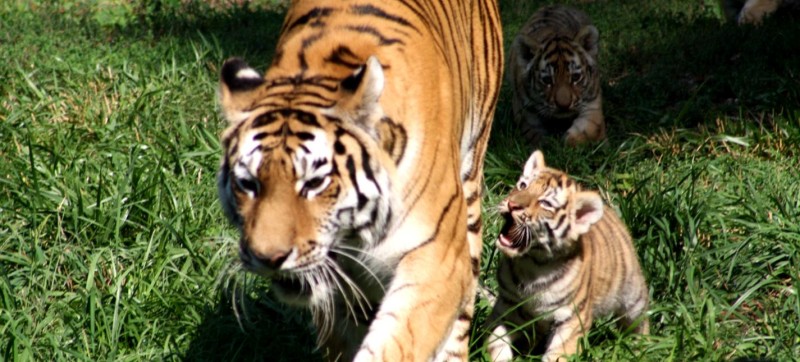Amur (Siberian) Tiger - Panthera tigris altaica



Habitat:
ranges from tundra to humid forests to coniferous bush-covered mountains up to 6600 feet
Range:
Found in Asia, mostly in Russia and China. The Amur River runs through the middle of their natural range
Activity Cycle:
Will hunt anytime of the day or night
Features:
Their fur grows longer and thicker than most tigers (up to 22 inches long in some spots). They have more white in their fur than other species. Their coat is more gold than the orange found on most tigers. They have less striping on the fur, and stripes are more brown than black. They have a ruff of fur found around the neck to help keep them warm.
Size:
the largest of the naturally breeding big cats- full grown males can reach lengths of 11 feet and 675 pounds, females can grow to 9 feet and 370 pounds. The largest recorded male was 13 feet in length and over 1000 pounds
Social Structure:
except for mothers and their dependant young, tigers generally live alone in their individual range. They keep in contact with other tigers by scent marking, claw marks and vocalizations
Life Expectancy:
average between 15-17 years in captivity
Diet:
big animals such as wild boar, elk and roe deer
Reproduction:
Tigers reach sexual maturity at 3-4 years of age. They breed between late January to April. They breed every 2-4 years. Their gestation period is between 92-113 days. Cubs can kill independently at around 7 months. By the time they are 2 years old, tigers can kill prey on their own, but may stay with mom for another year.
Status:
There are only 200-300 amur tigers left in the wild. The Amur tiger was the first animal to be a part of the Species Survival Plan (a captive breeding program that seeks to improve the prospects of endangered species) with the AZA. They are listed as endangered with both IUCN and USFWS.
Interesting Facts:
- Tigers are the only large cat with stripes.
- The stripe patterns of a tiger are not symmetrical from one side of the animal to another.
- Thickly furred feet are an adaptation for silent stalking. Their big paws act like snowshoes to help them move deeply into the snow.

AZA cooperatively manages this species as a Species Survival Plan® Program.
Video:
The YouTube ID of _F7LWxFkt88?t=1s is invalid.
Prices
- Adult (13 and over)$12.50
- Child (2 - 12)$9.00
- Child (1 and Under)FREE
- Senior (65+)$11.50
- Active Military$11.50
We begin transferring animals to evening (off exhibit) holding at 4:30 each night.
Find Us
2320 N. Prospect Rd.
Peoria, IL 61603
Phone: 309-686-3365
Open Daily 10:00-5:00
Last admission at 4:30
